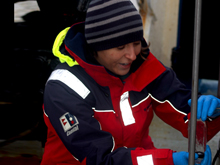
Marlene Jeffries fills a sample bottle with water from a Niskin bottle mounted to the rosette. During the 2009 RUSALCA expedition, she will collect close to 1,000 samples, which will be analyzed to reveal the Arctic Ocean's absorption of atmospheric carbon dioxide. Click image for larger view and image credit.
Examining CO2 Changes in the Arctic
September 25, 2009
Marlene Jeffries
Research Specialist
Bermuda Institute of Ocean Sciences
Why go to the cold Arctic when you live in warm and sunny Bermuda? To study CO2, of course!
How the Arctic Ocean uptakes atmospheric carbon dioxide (CO2 ) is a question, among others, that the Marine Biogeochemistry Lab at the Bermuda Institute of Ocean Sciences is trying to answer. With the retreat of sea ice over vast tracts of the Arctic Ocean in the summer, water that is undersaturated with respect to CO2 is exposed, potentially becoming a large "sink" for atmospheric CO2 in the ocean. As most of us know, atmospheric CO2 is a greenhouse gas that has been on the rise since the Industrial Revolution, and it is thought to play a significant role in global climate change.
Ocean acidification, also known as the “other CO2 problem,” is also a concern when considering how much CO2 the ocean is taking up and storing. Essentially, the addition of CO2 to seawater changes the chemistry of the ocean by lowering the pH, thus making the ocean more acidic. This has implications throughout the global ocean, because the more corrosive the water, the less hospitable the water is to many organisms that use carbonate ions to create their skeletons or shells (such as corals and bivalves) and calcifying phytoplankton (like coccolithophores).
As part of the RUSALCA mission, I am here to collect inorganic carbon samples of the Arctic Ocean and to help answer the questions above. As part of the Marine Biogeochemistry Lab at the Bermuda Institute of Ocean Sciences overseen by Dr. Nick Bates, I am taking nearly 1,000 separate samples that will be analyzed for dissolved inorganic carbon (DIC) and total alkalinity (TA).
So, how do we sample for carbon dioxide in the ocean? To sample for DIC and TA, we take water from Niskin bottles — the long, cylindrical bottles secured to the rosette. As the rosette descends through the water column, the bottles are remotely opened and closed at specific depths. By sampling water at various depths, ranging from the bottom to the top, we can create profiles of inorganic carbon at various places in the ocean.
Aboard the Russian research vessel Professor Khromov, the rosette returns to the uncovered back-deck area. So in addition to being subject to the elements, one also has to be careful about other sources of water contaminating the sample — rain, snow, even spray from an overzealous hose. It is important to collect the samples from the correct bottles, which are numbered according to the sampled depths. Once transferred into the smaller sample bottles, the water is treated with a poison to kill any organisms within it, because photosynthesis can continue changing the amount of inorganic carbon. Shipboard analysis of inorganic carbon samples is relatively rare, because of the amount of time it takes to run each sample (about 12 to 20 minutes each) and the fluctuating conditions in shipboard labs (such as temperatures and motion). Samples, therefore, are sealed and stored for later shore-side analysis.
As a first-time participant of the RUSALCA research cruises, our lab is hoping to compare these inorganic carbon measurements in 2009 to the upcoming cruise measurements in 2012. From this data, we hope to be able to answer our questions about how the changing Arctic is responding to CO2 increases.















